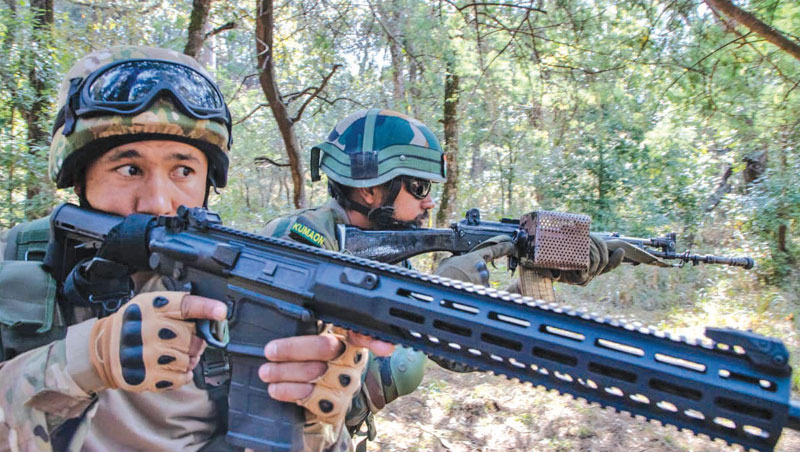Despite challenges, the Indian Army is focussing on sharpening its combat edge at the tactical level
Atul Chandra
The Indian Army is faced with the need to rapidly modernise its combat capabilities, a challenge further exacerbated by the long delayed modernisation of the world’s second largest standing army. While the army’s larger strategic challenges appear insurmountable given India’s limited ability to increase its defence spending by any substantial measure, the army has been inducting modern assault rifles, night vision devices, drones, loitering and precision guided munitions along with upgrading its armoured vehicles to increase its combat edge.

Small Arms Procurements
Largely putting to an end indigenous efforts to provide the army with assault rifles and carbines, the Ministry of Defence (MoD) inked a contract in December with Indo-Russian Rifles Private Limited (IRRPL) for supply of more than six lakh AK203 assault rifles.
These rifles will be produced at Korwa in Uttar Pradesh. IRRPL is a Joint Venture (JV) established between India, represented by the Defence PSUs - Advanced Weapons & Equipment India Limited (AWEIL) & Munitions India Limited (MIL) and Russia, represented by Rosoboronexport (RoE) and Concern Kalashnikov (CK), with a shareholding split of 50.5 per cent and 49.5per cent respectively. The JV was formed after the Inter-Governmental Agreement (IGA) signed between India and Russia in February 2019. India will be the first country to launch production of Kalashnikov’s AK200 series of rifles.
First unveiled in 2019, the Kalashnikov 200-series assault rifles (AK200, AK203, AK204 and AK205) made their debut at IDEX 2019 in the United Arab Emirates (UAE) and at Aero India 2019. The new Kalashnikovs feature the reliability, durability, and maintainability which AK series weapons are famed for but make use of modern materials, features improved ergonomics and compatibility with hi-tech accessories. The 7.62mm AK203 has a folding and adjustable buttstock, windowed and rifled magazine and a pistol grip. The rifle is fitted with an integral Picatinny rail. The AK203 fires 7.62х39mm caliber ammunition from a 30 round magazine and the assault rifle has an empty weight of 3.8kg.
The newest infantry small arm now in service with the army is the US made Sig Sauer SIG716 rifle. Sig Sauer completed deliveries for its first Indian order for 72,400 SIG716 rifles in the first quarter of 2020. The initial order for 72,400 SIG716 rifles was inked in February 2019 and was the first large Indian firearms procurement in decades. The SIG716 rifle underwent a comprehensive and exhaustive testing and evaluation process where it outperformed the competition. The SIG 716 is an enhanced AR platform featuring a 16-inch barrel, M-LOK handguard, and a 6-position telescoping stock. The procurement of additional Sig Sauer assault rifles for the army was also approved by the Defence Acquisition Council (DAC) in September 2020. The additional deal for SIG716 rifles will be worth approximately Rs.780 crore. Sig Sauer is manufacturing SIG716 rifles for the Indian Army at its New Hampshire facility in the USA.
The development of indigenous small arms continues to be a bugbear for the Defence Research & Development Organisation (DRDO), which continues to strive for success in this arena and is developing a 5.56x30mm protective carbine. The gas operated semi bull-pup 5.56x30mm automatic carbine was first unveiled at DefExpo 2020. The new weapon successfully completed final user trials in December 2020, meeting the army’s demanding General Staff Qualitative Requirements (GSQR). It has also passed trials with the ministry of home affairs (MHA), with orders likely to be placed by the Central Armed Police Forces (CAPF). The carbine weighs three kg and has a rate of fire of 700 rpm, with an effective range of more than 100 m. The weapon is well suited for Counter Insurgency/ Counter Terrorism operations. The carbine has been developed by the Armament Research and Development Establishment (ARDE), a Pune based laboratory of DRDO.
The new carbine will be manufactured at Small Arms Factory, Kanpur while its ammunition will be produced at Ammunition Factory, Kirkee, Pune. The army is also replacing its World War-II vintage hand grenades with more modern designs. Economic Explosives Limited (EEL) delivered the first batch of Multi-Mode Hand Grenades (MMHG) to the army in August. EEL will supply 10 lakh modern grenades to the army and air force at a cost of Rs.409 crore under a contract inked in October 2020. EEL is a subsidiary of Nagpur based Solar Group and was contracted in October 2020 to supply the army with the new Multi-Mode Hand Grenades. It has been provided with a Transfer of Technology (ToT) from Terminal Ballistics Research Laboratory in 2016 and has successfully absorbed the technology to receive bulk production clearance in May 2021.
Missile Systems
A new weapon system developed by DRDO, is the indigenous ‘Pralay’ surface-to-surface missile. Flight tests of the missile commenced in December and it is being developed under the ‘fast-track’ mode by DRDO. Touted as a new generation surface-to-surface missile, the Pralay missile features a solid propellant rocket motor and several new technologies. It has a range of 150-500 km and the missile’s guidance system includes a state-of-the-art navigation system and integrated avionics. The surface-to-surface missile can be launched from a mobile launcher.
The DRDO developed Pinaka Extended Range (Pinaka-ER) rocket recently also underwent tests at the Pokhran ranges. The Pinaka-ER Multi Barrel Rocket Launcher (MBRL) System is an upgraded version of the earlier Pinaka version which has completed a decade in service with the Indian Army. The series of performance evaluation trials of industry produced rockets were conducted by the army at its Field Firing Ranges over a period of three days, with Pinaka-ER rockets test fired at different ranges with various warhead capabilities. A total of 24 rockets were fired for different ranges and warhead capabilities to meet the objectives of accuracy and consistency.
You must be logged in to view this content.

